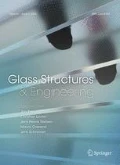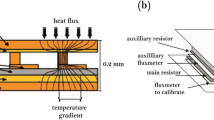Abstract
The use of glass and, in particular, laminated glass (LG) in the building industry is a continuously rising trend. Thus, in order ensure a safe fracture and a post-breakage load bearing capacity but still be economical, the consideration of the shear transfer by the polymeric interlayer between the glass panes is gaining importance in the structural design. This also relates to future European harmonised product and design standards in glass construction. In addition to simple models using particular shear modulus values for certain load situations and temperatures, linear viscoelastic material models for the interlayer can be applied for more complex design situations. We present the basics of mechanical modelling of the time- and temperature dependent material behaviour of polymers used in LG. The procedure for the experimental determination of the material parameters is explained for the most common product polyvinyl butyral. For practical application in glass design, different standards (national and international) and other building regulations are compared. The analysis of the compliant composite shows that already low shear modulus values lead to a significant reduction in glass stresses. Finally, a comparative example shows the design of laminated glass considering the shear transfer with different methods.













Similar content being viewed by others
References
Andreozzi, L., Bati, S.B., Fagone, M., Ranocchiai, G., Zulli, F.: Dynamic torsion tests to characterize the thermo-viscoelastic properties of polymeric interlayers for laminated glass. Constr. Build. Mater. 65, 1–13 (2014). https://doi.org/10.1016/j.conbuildmat.2014.04.003
Arzoumanidis, G.A., Liechti, K.M.: Linear viscoelastic property measurement and its significance for some nonlinear viscoelasticity models. Mech. Time-Depend. Mater. 7(3–4), 209–250 (2003). https://doi.org/10.1023/B:MTDM.0000007357.18801.13
AS 1288: Glass in buildings—Selection and Installation. (2006)
ASTM D4065: Standard Practice for Plastics: Dynamic Mechanical Properties: Determination and Report of Procedures. (2006)
ASTM E1300-16: Standard Practice for Determining Load Resistance of Glass in Buildings. (2016)
Botz, M., Kraus, M., Siebert, G.: Sensitivity analysis for the determination of the interlayer shear modulus in laminated glass using a torsional test. Glass Struct. Eng. 3(2), 355–371 (2018). https://doi.org/10.1007/s40940-018-0067-8
Brinson, H.F., Brinson, L.C.: Polymer Engineering Science and Viscoelasticity—An Introduction. Springer, Berlin (2008)
Callewaert, D., Belis, J., Delincé, D., Impe, R.V.: Experimental stiffness characterisation of glass/ionomer laminates for structural applications. Constr. Build. Mater. 37, 685–692 (2012). https://doi.org/10.1016/j.conbuildmat.2012.07.035
Christoffer, J.: Ermittlung von Schneelasten in Abhängigkeit von der Liegedauer-Abschlussbericht des Deutschen Wetterdienstes gefördert durch das Institut für Bautechnik. Stuttgart, (1990)
CNR-DT 210: Guide for the Design, Construction and Control of Buildings with Structural Glass Elements. (2013)
E DIN 18008-1: Glas im Bauwesen—Bemessungs- und Konstruktionsregeln—Teil 1: Begriffe und allgemeine Grundlagen. (2018)
E DIN 18008-2: Glas im Bauwesen—Bemessungs- und Konstruktionsregeln—Teil 2: Linienförmig gelagerte Verglasungen. (2018)
EN ISO 6721-1: Plastics–Determination of dynamic mechanical properties–Part 1: General principles. (2011)
EN ISO 12543-2: Glass in building–Laminated glass and laminated safety glass–Part 2: Laminated safety glass (ISO 12543-2:2011); German version. (2011)
EN ISO 12543-3: Glass in building–Laminated glass and laminated safety glass–Part 3: Laminated glass (ISO 12543-3:2011); German version. (2011)
Ensslen, F.: Zum Tragverhalten von Verbund-Sicherheitsglas unter Berücksichtigung der Alterung der Polyvinylbutyral-Folie. PhD-Thesis, Ruhr-Universität Bochum (2005)
Galuppi, L., Royer-Carfagni, G.: Effective thickness of laminated glass beams. New expression via a variational approach. Eng. Struct. 38, 53–67 (2012a)
Galuppi, L., Royer-Carfagni, G.: The effective thickness of laminated glass plates. J. Mech. Mater. Struct. 7(4), 375–400 (2012b). https://doi.org/10.2140/jomms.2012.7.375
Galuppi, L., Royer-Carfagni, G.: The effectivethickness of laminated glass: inconsistency of the formulation in a proposal of EN-standards. Compos. Part B: Eng. 55, 109–118 (2013). https://doi.org/10.1016/j.compositesb.2013.05.025
Galuppi, L., Royer-Carfagni, G.: The design of laminated glass under time-dependent bending and buckling. Challenging Glass 4 & COST Action TU0905 Final Conference (2014a)
Galuppi, L., Royer-Carfagni, G.: Enhanced effective thickness of multi-layered laminated glass. Compos. Part B: Eng. 64, 202–213 (2014b). https://doi.org/10.1016/j.compositesb.2014.04.018
Gräf, H.: Untersuchungen zum Tragverhalten von Verbundsicherheitsglas bei linienförmiger und punktueller Lagerung. PhD-Thesis, TU München (2003)
Kasper, R.: Tragverhalten von Glasträgern. PhD-Thesis, RWTH Aachen (2005)
Kraus, M.A., Schuster, M., Kuntsche, J., Siebert, G., Schneider, J.: Parameter identification methods for visco- and hyperelastic material models. Glass Struct. Eng. 2(2), 147–167 (2017). https://doi.org/10.1007/s40940-017-0042-9
Kuntsche, J., Schuster, M., Schneider, J., Langer, S.: Viscoelastic properties of laminated glass interlayers—theory and experiments. Glass Perform. Days, Tampere, Finland 2015, 143–147 (2015)
Kuntsche, J.: Mechanisches Verhalten von Verbundglas unter zeitabhängiger Belastung und Explosionsbeanspruchung (Mechanical behaviour of laminated glass under time-dependent and explosion loading). PhD-Thesis, Technische Universität Darmstadt(2015)
Kutterer, M.: Verbundglasplatten—schubverbund und membrantragwirkung. Stahlbau 74(1), 39–46 (2005)
NBN S 23-002: Glaswerk–Deel 2 : Berekening van de glasdikte. Glaswerk–Deel 2 : Berekening van de glasdikte. (2016)
NEN 2608: Vlakglas voor gebouwen- Eisen en bepalingsmethode (Glass in building—Requirements and determination method). (2014)
NF DTU 39 P4: Mémento Calculs pour le dimensionnement des vitrages. (2012)
NS 3510: Sikkerhetsruter i byggverk - Krav til prosjektering og-klasser for ulike bruksområder (Safety glass in constructionworks Requirements for design and classes in various application areas). (2015)
ÖNORM B 3716-1: Glas im Bauwesen—Konstruktiver Glasbau Teil 1:Grundlagen (Glass in building—Structural glass construction—Part1: Basic principles). (2015)
Park, S.W., Kim, Y.R.: Fitting prony-series viscoelastic models with power-law presmoothing. J. Mater. Civil Eng. 13(1), 26–32 (2001). https://doi.org/10.1061/(asce)0899-1561(2001)13:1(26)
prCENTS-1: Structural glass–Design and construction rules–Part 1: Basis of design and materials. (2017)
prCENTS-2: Structural glass–Design and construction rules–Part 2: Out-of-plane loaded glass components. (2017)
prEN 16612: Glass in building—Determination of the lateral load resistance of glass panes by calculation. (2017)
Riande, E., Diaz-Calleja, R., Prolongo, M., Masegosa, R., Salom, C.: Polymer Viscoelasticity Stress and Strain in Practice. Marcel Dekker Inc, New York (2000)
Rösler, J., Harders, H., Bäker, M.: Mechanisches Verhalten der Werkstoffe, vol. 4. Springer Vieweg, Berlin (2012)
Schneider, J., Kuntsche, J., Schula, S., Schneider, F., Wörner, J.-D.: Glasbau Grundlagen, Berechnung, Konstruktion, vol. 2. Springer, Berlin (2016)
Schuler, C.: Einfluss des Materialverhaltens von Polyvinylbutyral auf das Tragverhalten von Verbundsicherheitsglas in Abhängigkeit von Temperatur und Belastung. PhD-Thesis, TU München (2003)
Schuster, M., Kraus, M., Schneider, J., Siebert, G.: Investigations on the thermorheologically complex material behaviour of the laminated safety glass interlayer ethylene-vinyl-acetate. Glass Struct. Eng. 3(2), 373–388 (2018). https://doi.org/10.1007/s40940-018-0074-9
Schwarzl, P.D.F.R.: Polymermechanik. Springer, Berlin (1990)
Speelman, R.S., G.: Laminated glass and interlayers–breaking the myths. Glass Performance Days, Tampere, Finland 2013, pp. 235–237 (2013)
Stamm, K., Witte, H.: Sandwichkonstruktionen. Springer, Wien (1974)
Williams, M.L., Landel, R.F., Ferry, H.D.: The Temperature Dependence of Relaxation Mechanisms in Amorphous Polymers and Other Glass-forming Liquids. J. Am. Chem. Soc. 77(14), (1955). https://doi.org/10.1021/ja01619a008
Wölfel, E.: Nachgiebiger Verbund: Eine Näherungslösung und deren Anwendungsmöglichkeiten. Stahlbau 56(6), 173–180 (1987)
Z-70.3-170: Allgemeine bauaufsichtliche Zulassung Z-70.3-170: Verbund-Sicherheitsglas mit SentryGlas\(^{{\textregistered }}\) SGP 5000 mit Schubverbund. (2016)
Z-70.3-175: Allgemeine bauaufsichtliche Zulassung Z-70.3-175: Glascobond\(^{{\textregistered }}\) Verbund-Sicherheitsglas mit Schubverbund. (2016)
Z-70.3-197: Allgemeine bauaufsichtliche Zulassung Z-70.3-197 Verbund-Sicherheitsglas mit einer Verbundfolie der Produktfamilie EVASAFE mit Ansatz eines Schubverbundes. (2014)
Z-70.3-230: Allgemeine bauaufsichtliche Zulassung Z-70.3-230 Verbundsicherheitsglas aus der Produktfamilie SAFLEX DG mit Schubverbund. (2016)
Z-70.3-236: Allgemeine bauaufsichtliche Zulassung Z-70.3-236 Verbund-Sicherheitsglas mit der PVB-Folie TROSIFOL ES mit Schubverbund. (2016)
Z-70.3-240: Allgemeine bauaufsichtliche Zulassung Z-70.3-240: GEWE-composite Verbund-Sicherheitsglas mit Schubverbund. (2016)
Z-70.4-137: Allgemeine bauaufsichtliche Zulassung Z-70.4-137: Verbund-Sicherheitsglas “LAMEX X-STRONG”. (2015)
Z-70.4-165: Allgemeine bauaufsichtliche Zulassung Z-70.4-165: Verbund-Sicherheitsglas mit PVB-Folie “SGT extra safe” mit Ansatz des Schubverbundes. (2016)
Author information
Authors and Affiliations
Corresponding authors
Additional information
Publisher's Note
Springer Nature remains neutral with regard to jurisdictional claims in published maps and institutional affiliations.
Rights and permissions
About this article
Cite this article
Kuntsche, J., Schuster, M. & Schneider, J. Engineering design of laminated safety glass considering the shear coupling: a review. Glass Struct Eng 4, 209–228 (2019). https://doi.org/10.1007/s40940-019-00097-3
Received:
Accepted:
Published:
Issue Date:
DOI: https://doi.org/10.1007/s40940-019-00097-3




